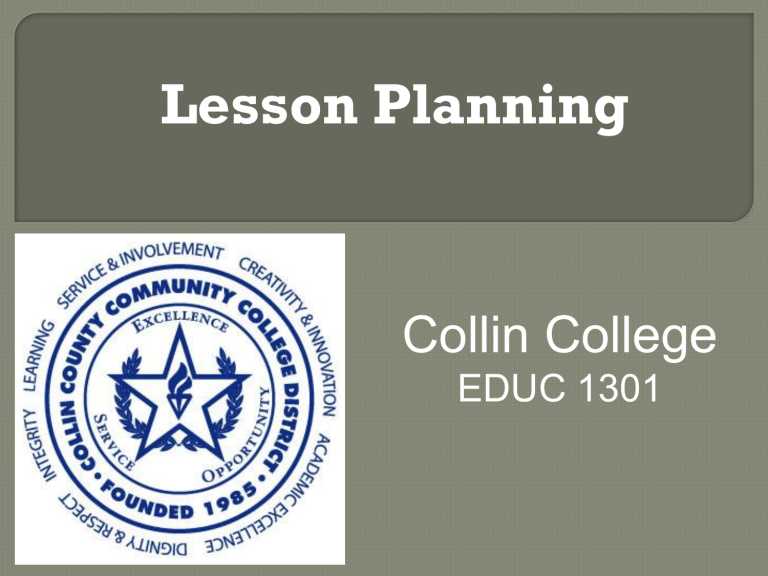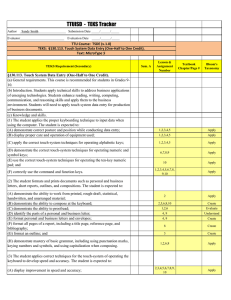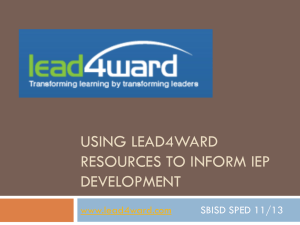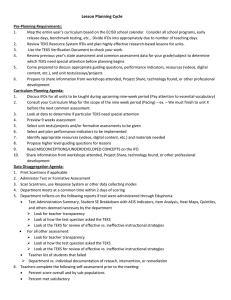Lesson Planning

Lesson Planning
Collin College
EDUC 1301
Identify interests, TEKS
Brainstorm (What do you wonder or What would you like to know about) using a web format (see coming slide)
Identify curricular areas and create a curriculum web
Develop Activities and Put into lesson plan
Locate materials
Conduct activities
Evaluate unit
Keep the Ideas and materials that worked!
Using Books to lesson plan!
Brainstorming
Brainstorming
Web
Curriculum Web
CurriculumPlanning
Web
TEKS
Objective/Outcomes
(TSW)
Rationale
Lesson Plan
Anticipatory Set or Introduction
Process
•
• Instructional strategies you will use to teach the lesson
Questions (based on various levels of Bloom’s
Taxonomy)
• Closure
Bloom’s Taxonomy
Practice
Materials/Equipment
Area of Development
Physical Social
Emotional Intellectual
Accomodations
Differentiated Learning
Styles
Classroom Strategies
Curriculum Integration
Assessment/Evaluation
Resources (APA)
Copyright by Houghton Mifflin Company. All rights reserved.
9 -
5
First do a brainstorming web (see next slide)
Use your ideas from webbing
Determine your basic curricula areas, such as math, science, etc…
Create a curriculum web putting in specific activities under each curricula area (use your brainstorming web for ideas)
Create your lesson plan
Detail your activities:
•
•
•
Materials needed
Time needed
Domains of development covered
A lesson is the smallest individual piece of a concept, theme, or topic to be taught
A lesson should only include one element to avoid confusion or overload
Once students have mastered a lesson, the teacher can move on to the next piece
A lesson is NOT necessarily what can be covered in 45 minutes or bell-to-bell
Individual lessons make up a unit
7
The “what” for the lesson. What is(are) the expectation(s) for the student. What will they learn or be able to do as a result of the lesson?
Daily/Lesson objectives should align with your long-range goals and district curriculum and the TEKS
Example: The student will be able to correctly identify at least 45 of the 50 U.S.
State Capitals on the unit exam.
8
TEKS (Objective)
In Texas, you must list the TEKS addressed in the lesson alongside the objective(s).
If you can’t find a corresponding TEKS for your objective, then DON’T teach it.
Cite your TEKS as below:
6th Grade Mathematics: 111.22(b)(9)(B) – “Find the probability of a simple event and it’s compliment and describe the relationship between the two.”
9
Parts of a Good Objective
Conditions – under which the behavior is to be performed
Behavioral Verb – action word that connotes an observable student behavior
Criteria – specifies how well the student must perform the behavior
10
Knowledge
Comprehension
Application
Analysis
Synthesis
Evaluation
(See handout in back of Lab Manual)
.
9 -
11
Cooperative Groups
Technology
Independent
Activities
Charts/Graphs/Maps
Problem Solving
Peer tutoring
Hand-On Centers
Simulation
Lecture
Whole-group Activity
Pairing
Copyright by Houghton Mifflin Company. All rights reserved.
9 -
12
An activity where the teacher formally determines that students learned the knowledge or skills outlines in the lesson objective(s)
Lesson assessments should directly measure the objectives (TEKS)
Examples:
• Test or exam, project, term paper, presentation, rubric, written or verbal report, performance of understanding, activity
Copyright by Houghton Mifflin Company. All rights reserved.
9 -
13
Citation Machine http://citationmachine.net/index2.php
Include at least two resources – include one article or book and one on-line resource
Copyright by Houghton Mifflin Company. All rights reserved.
9 -
14







